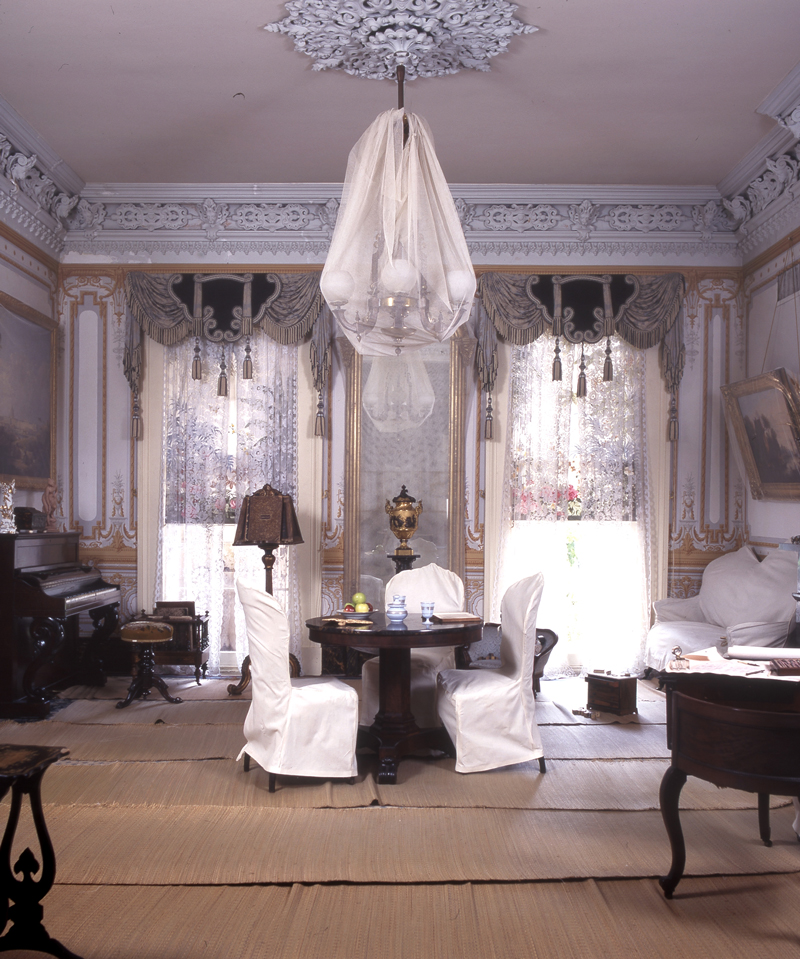Summer in the City
Summer in New Orleans means a hot, humid, almost oppressive environment settles in over the city for a long four months. Today residents can shut the doors and windows, turn on their air conditioning unit, and relax away from the unbearable heat. However, nineteenth-century Orleanians were not so fortunate. To enjoy the benefits of a kind breeze, one had to open the doors and windows, leaving one’s self and home vulnerable to the mud, odors, and flying insects of the street outside. In order to protect their home from the elements, the people of New Orleans would completely redecorate once a year, going into “Summer Dress.”
Summer Dress began in May and lasted generally until October. It entailed a complete overhaul of the household. Anything that would contribute to the overbearing heat or could be easily damaged by it had to be dealt with by being covered up or removed entirely. Many families chose to put newspaper and straw matting over the wooden floors, pulling up and removing the expensive and imported wall to wall wool carpeting which was commonplace in most homes. While the carpeting was more fashionable it “seems to add to the heat of the room, is very uncomfortable to the feet when the shoes and stockings are off, and causes an accumulation of dust, which seldom fails to produce insects, and is in every respect a great sacrifice of convenience to show.”¹
This line of reasoning extended to draperies, often times for wealthier families made out of velvet or silk damask, which would keep breezes out and moisture in while fading from the intense sunlight. Instead, light lace curtains or linen window shades would be put up, providing privacy and sun protection without being as susceptible to damage.
The stuffy yet necessary mosquito netting covering the bed.
Anything upholstered, like sofas and chairs, would be covered with a lightweight and washable slipcover. Usually made out of cotton or muslin, slipcovers would protect the delicate upholstery while maintaining the light and airy appearance of Summer Dress. The final protective measure was to cover the beds and anything that was gilded with netting.
During the night, you had to sleep under mosquito netting to protect yourself from the insects despite the netting allowing for little air to go through. Objects like paintings, mirrors, clocks, or anything with glass, metal, and gilding also had to be covered. The humidity made these objects more malleable and susceptible to little black spots left by flies landing there. Even the chandeliers were covered, families instead opting for candles or table light.
It’s hard to say how many families would stay in town to enjoy all of their hard work, with many choosing instead to vacation upriver, on the gulf coast, or even travel to Europe to escape the heat and diseases that permeated New Orleans.² Regardless, it’s safe to say that the local’s feelings towards “the roasting, melting, stewing, killing temperature of the atmosphere,” remain unchanged from the 1800s.³
Sources:
¹Leslie, Eliza. Miss Leslie’s Lady’s House-Book: A Manual of Domestic Economy. Philadelphia: A. Hart, 1850.
² Bachand, Marise. A Season in Town: Plantation Women and the Urban South, 1790-1877. 2011.
³Daily Crescent (New Orleans, LA), July 2, 1858.


